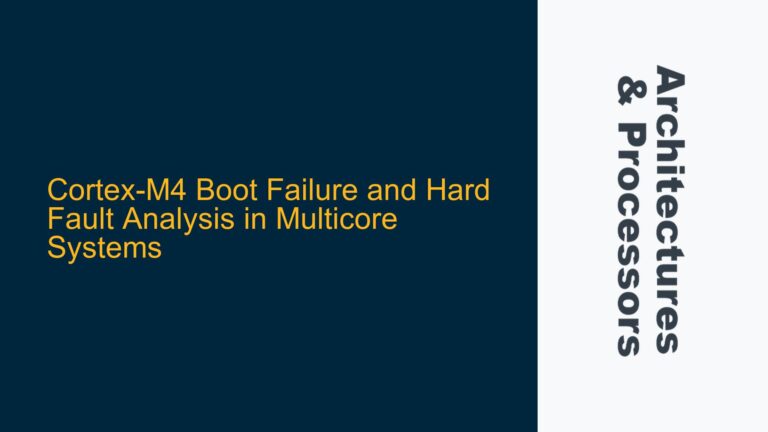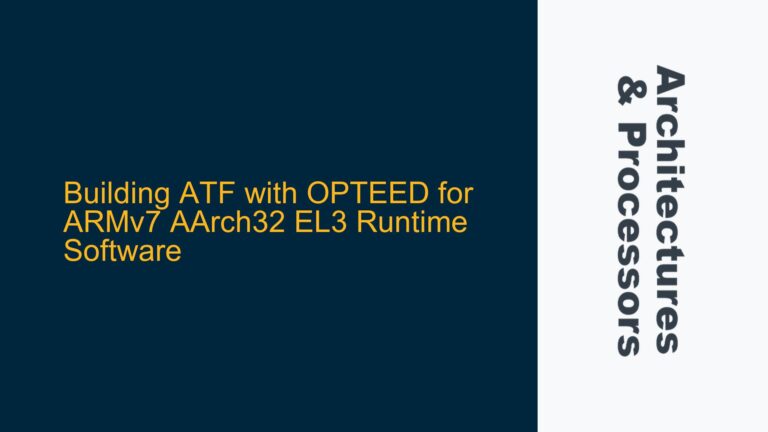ARM PMCCNTR_EL0 Access Trapping in KVM Guest Virtual Machines
Accessing the ARM Performance Monitors Cycle Count Register (PMCCNTR_EL0) directly from a KVM-based guest virtual machine (VM) can be a challenging task due to the trapping mechanism enforced by the hypervisor at Exception Level 2 (EL2). The PMCCNTR_EL0 register is a critical component for performance monitoring, as it provides a cycle count that can be used to measure execution time and performance metrics. However, when running in a virtualized environment, direct access to this register is often intercepted by the hypervisor, leading to significant overhead and inaccurate measurements, especially when frequent access is required.
The primary issue arises from the fact that the hypervisor, operating at EL2, traps accesses to certain privileged registers, including PMCCNTR_EL0, to maintain control over the guest VM. This trapping mechanism ensures that the hypervisor can manage resources and enforce security policies, but it introduces latency and overhead that can skew performance measurements. For researchers and developers aiming to measure world-switch costs or other fine-grained performance metrics, this trapping behavior can be a significant obstacle.
In addition to the trapping issue, the use of Dynamic Voltage and Frequency Scaling (DVFS) can further complicate cycle count measurements. DVFS adjusts the processor’s voltage and frequency based on workload demands, which can lead to inconsistent cycle counts. While disabling DVFS can mitigate this issue, it does not address the fundamental problem of hypervisor-induced trapping.
Hypervisor Trapping and Generic Timer Alternatives
The trapping of PMCCNTR_EL0 accesses by the hypervisor is a deliberate design choice to maintain control over the guest VM. The hypervisor must ensure that privileged operations, such as accessing performance counters, do not compromise the stability or security of the system. However, this design choice can be problematic for performance-sensitive applications that require frequent and accurate cycle count measurements.
One possible alternative to using PMCCNTR_EL0 is to leverage the ARM Generic Timer, which provides virtual and physical count registers. The Generic Timer is designed to offer a consistent and reliable time source that is not affected by DVFS or other frequency scaling mechanisms. The virtual count register (CNTVCT_EL0) and the physical count register (CNTPCT_EL0) can be accessed directly from the guest VM without trapping to the hypervisor, making them suitable for performance measurements in virtualized environments.
The Generic Timer operates independently of the processor’s clock frequency, providing a stable time reference that can be used to measure elapsed time with high precision. While the Generic Timer does not provide cycle counts, it can be used to infer performance metrics by measuring the time taken to execute specific code segments. This approach can be particularly useful when the primary goal is to measure world-switch costs or other time-based performance metrics.
However, it is important to note that the Generic Timer may not be suitable for all use cases. For example, if the goal is to measure the exact number of cycles taken by a specific instruction or code segment, the Generic Timer may not provide the required level of granularity. In such cases, alternative approaches, such as using performance monitoring units (PMUs) or custom hardware counters, may be necessary.
Implementing Direct PMCCNTR_EL0 Access and Optimizing Generic Timer Usage
To enable direct access to PMCCNTR_EL0 from a KVM guest VM, several steps can be taken to configure the hypervisor and the guest operating system. First, the hypervisor must be configured to allow direct access to the PMCCNTR_EL0 register. This can be achieved by modifying the hypervisor’s trap settings to exclude PMCCNTR_EL0 from the list of trapped registers. However, this approach requires careful consideration of the security implications, as it may expose the system to potential vulnerabilities.
Once the hypervisor is configured to allow direct access, the guest operating system must be modified to access PMCCNTR_EL0 without causing a trap. This typically involves writing custom assembly code or using low-level system libraries to read the register directly. It is also important to ensure that the guest operating system is aware of any changes to the hypervisor’s trap settings, as this may affect other privileged operations.
In cases where direct access to PMCCNTR_EL0 is not feasible, the Generic Timer can be used as an alternative. To optimize the use of the Generic Timer, the guest operating system should be configured to access the virtual or physical count registers directly. This can be achieved by using the appropriate system calls or low-level libraries to read the registers without trapping to the hypervisor. Additionally, the guest operating system should be configured to disable DVFS or other frequency scaling mechanisms that may affect the accuracy of the timer.
When using the Generic Timer, it is important to consider the resolution and accuracy of the timer. The Generic Timer typically provides a resolution of a few nanoseconds, which is sufficient for most performance measurements. However, for applications that require higher precision, it may be necessary to use additional techniques, such as averaging multiple measurements or using custom hardware counters.
In summary, accessing the ARM PMCCNTR_EL0 cycle counter directly from a KVM guest VM can be challenging due to hypervisor trapping. However, by configuring the hypervisor and guest operating system appropriately, it is possible to enable direct access to the register. Alternatively, the ARM Generic Timer can be used as a reliable and consistent time source for performance measurements in virtualized environments. By carefully considering the trade-offs and optimizing the use of available resources, it is possible to achieve accurate and reliable performance measurements in a KVM-based guest VM.






